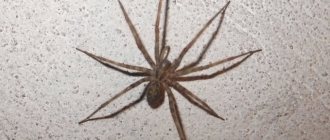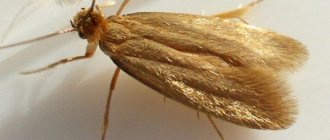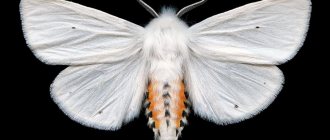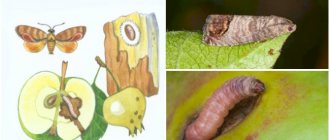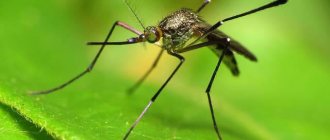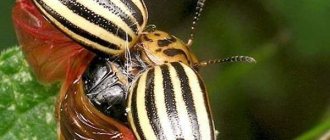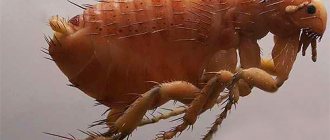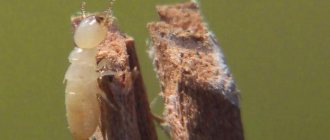There are a large number of species of moths. Not all of them are voracious and cause harm to humans in the form of damaged linen, food, furniture and carpets.
Information about moth species is divided into the following chapters:
- Moths that harm humans or nature
- General characteristics of moths
- Moth Reproduction
- The most famous types of moths
- Black moth
- Description of black moth
- What harm does black moth cause?
- White moth
- What harm does white moth cause?
general characteristics
The insect looks like a small butterfly; there is no bright color or external distinctive features. The color of the pest depends on its habitat in order to better camouflage itself. Adults differ from butterflies in the absence of a proboscis. The moth does not feed on anything. It replenishes its energy reserves from accumulated substances while being a caterpillar. Its main task is reproduction. Moths do not harm humans.
It is important!
Larvae of various types of moths cause significant damage to property and products!
They also leave excrement where they live. Adult pests are afraid of sunlight. Therefore, their place of residence is hidden and dark places.
Moth Reproduction
The female releases pheromones, which the male flies towards, and the mating process begins. After 6 hours the female lays eggs. Their number can reach 100 pieces. If conditions are favorable, larvae appear within a week. Their body is white and transparent, and their size is no more than 1 mm.
Interesting to know!
Pregnant females practically do not fly. Only males fly.
The caterpillars are also inactive. They molt several times. This period takes from 40 days to 2.5 years. Developed individuals weave a cocoon in which they then pupate.
Argus
Length – 11-15 mm, wingspan – 24-30 mm.
Unlike its brown counterpart, male Argus bluegills have brown and blue wings. In females they are simply brown, with a characteristic fringe at the ends. And below - gray-beige, with orange and black spots.
Argus live mainly on heather heaths and large areas. Summer time is from June to August, and in the fall butterflies lay eggs that safely survive the winter. In spring, brown-green caterpillars with a dark stripe emerge from them and feed on heather and legumes.
The favorite place for pupation is anthills. The pupae secrete a sweet liquid, and the ants take care of them for this.
The most famous types of moths
- Indoor (clothes) moth:
Feeds on wool, cotton, and natural fabric of upholstered furniture. Lives in cabinets, hiding in the folds of clothes. - Furniture moth
Size up to 10 mm. Flies and breeds in early spring and late summer. It lives in furniture and feeds on it. - Kitchen (food) moth
Has a characteristic pattern on 5 wings. Lives in the kitchen and food storage areas. The pest enters the premises from contaminated products brought in. Mating and egg laying occur in the place where the moth lives. It is important to know!
Products spoiled by moths are no longer suitable for consumption.- Household (fur) moths
can ruin an expensive fur product in a short period of time. Adults are small in size and have small black dots on their wings. The larvae are white. Prefers to eat natural furs and fabrics. - Carpet moths
love to feed on silk and wool coverings, but will also eat artificial carpets. Habitat: furniture, cabinets, wood. - Grain moth
Lays eggs on food products, which are then destroyed by caterpillars. These are flour, seeds, dried fruits, cereals, cereals. - Potato moth
feeds on potatoes, eggplants, tobacco, tomatoes, and peppers. It breeds only in warm weather. - Granary grain moth
lives in houses, warehouses and agricultural lands. Food - dried fruits, nuts, cereals, seeds, mushrooms, berries, flour. - Poplar moth
Habitat: poplars.
Summer begins in spring. Advice!
Do not open the windows at this time to prevent poplar moths from entering your home. - Cabbage moth
Life expectancy is 30-35 days. With the beginning of spring work, summer begins. It eats cabbage or mustard.
Preventive measures
It is better to prevent the appearance of moths in the kitchen in time than to subsequently waste time and effort on exterminating pests:
- It is highly not recommended to store food products (flour, cereals) for a long time. It is better to buy more provisions after 2-3 weeks than to throw away spoiled food later. If there are a lot of stocks of long-lasting cereals in the house, then they need to be reviewed from time to time.
- A safe place to store bulk products is containers with tight-fitting lids. The container material can be anything - glass, plastic, tin. Improper storage of cereals in plastic bags leads to contamination of the contents.
- It is not advisable to leave fruits in the open air, but rather store them in the refrigerator.
- Place bags of different herbs that have an unpleasant odor for moths in kitchen cabinets.
- Place a pot of geraniums on the windowsill. The plant repels moths with its smell.
- Cover the ventilation hole with a mesh with 1 mm mesh.
- Ventilate kitchen cabinets regularly and often.
WATCH THE VIDEO
Fighting moths is an unpleasant process, but if you follow the recommendations, you can forget about this insect for a long time. It is possible to destroy moths in an apartment only through comprehensive measures. The main thing is to act in the first hours. Now you know how to get rid of moths in the kitchen. Ask your questions in the comments.
Black moth
This insect can breed even in a perfectly clean kitchen. It is quite difficult to get rid of black moths due to their rapid reproduction. Basically, it starts in long-stored cereals.
Description of black moth
Black moth is considered a harmful insect. Only males fly indoors and do not pose a threat. During the same period, females lay silvery eggs. These are the ones that pose a danger to products.
Interesting to know!
Black moths die from sunlight within an hour!
The insect lives in warm and dark places, with a lack of fresh air. The greatest danger comes from the caterpillars, which devour everything that gets in their way. In most cases, they cause damage to all kinds of products, but cereals and dried fruits are most often affected.
What harm does black moth cause?
When black moths appear in a room, you need to carefully examine dried fruits, seasonings, oatmeal, cereals, and muesli. The eggs of this voracious pest look like cobwebs. The size of the larvae is 1 cm, and the head is black.
Interesting to know!
Eggs and larvae of black moths die from low temperatures within 24 hours.
If affected supplies are found, they must be disposed of immediately. They can no longer be saved. And insects will very quickly settle in all products, including those that are in closed jars. The pest is not able to penetrate only glass or metal containers.
Advice!
Ventilate your rooms more often! Black moths do not like fresh air.
Fighting methods
- In order to get rid of a pest, it is necessary, first of all, to find the product in which the larvae have settled and get rid of it as quickly as possible.
- Then you need to check all the cereals, flour, nuts, dried fruits, mushrooms, pet food and other dry foods in the kitchen to determine the presence or absence of insects. Pay special attention to those that are stored for a long time.
- If there is little grain left, or the pest infestation is already significant , it is better to throw it away to avoid reappearance.
- All remaining bulk products must be fried in the oven or in a frying pan or frozen for several days.
- After getting rid of the source of infection, you need to thoroughly wash all kitchen cabinets with soapy water , rinse with clean water and preferably treat with a brush dipped in table vinegar. Leave the doors open until completely dry.
After such manipulations, it is necessary to treat the room with special anti-moth products.
Chemicals
Nowadays, stores have a huge selection of various chemicals that will help get rid of both adult insects and larvae.
They can be divided into two groups:
- Insecticides, poisonous agents that kill an existing pest.
- Repellents are plant-based substances that repel parasites, preventing them from laying eggs.
Types of funds
Insecticides are manufactured in the following forms:
- Aerosols are a very effective, but at the same time dangerous, remedy. When using them, it is necessary to take into account toxicity and harm to all living things in the apartment. Such products must be used exactly in accordance with the instructions, while observing all necessary safety measures. Before starting to treat the premises, it is necessary to remove all food supplies, dishes, and pets from it. After achieving the result, ventilate the kitchen well and thoroughly wash all surfaces where the toxic agent could get in.
- Fumigator plates contain special preparations that have a detrimental effect on both adult moths and larvae. When the fumigator is turned on, the plates heat up and evaporate the toxic substance.
- Solid preparations in the form of crystals or balls that act on the same principle as a fumigator.
They come in several types:
- Traps are sticky tapes that have a specific smell that attracts insects.
- Tablets or plates that repel adults with their smell.
Review of the best moth repellents
- Aerosol "Raptor" acts on both adults and larvae and has a long-lasting effect. Can be sprayed on any surface. The downside is the pungent, acrid smell. Price about 300 rubles.
- Aerosol against crawling and flying insects “Raid” also has an unpleasant odor and is effective for 6 months. Price – 270-300 rubles.
- Spray "Mosquitall" - the same mode of action as other products. Price – approximately 150 rubles.
- Liquid for fumigator "Mosquitall". Designed for 60 days. Price – 150 rubles.
- Raptor moth sections, one of the most effective products in this segment, act on moths from the moment they appear. Price – 100 rubles.
- Aeroxon food moth traps containing pheromones that attract male moths, which stick to the surface when they land. Price – about 280 rubles.
- The Raptor trap, like the previous product, does not have a strong odor, so it is recommended for use in small enclosed spaces. Price – 200 rubles.
- Antimol tablets with lavender scent. Does not pose a danger to humans. Several pieces are placed in fabric bags and laid out on grocery shelves. Price – 17 rubles per piece.
- Balls against moths "Taiga". Herbal medicine with natural oils is safe for health. Price – 22 rubles.
Folk remedies
Opponents of using chemicals in a house or apartment can try to get rid of moths using traditional methods: garlic, herbs, spices.
Moths are afraid of strong odors, which scare them away. It is this property that can be used when fighting pests. Some plants and spices have this smell:
- Garlic: Peel a few cloves and place in areas where moths live. It does not affect the smell and taste of products.
- the bay leaf around the perimeter in the cabinets where cereals and other “groceries” are stored.
- Cloves, rosemary, allspice and other spices with a pungent odor should be placed in containers where cereals are stored.
- Place herbs such as rosemary, lavender, basil, wild rosemary in fabric bags and place them in storage areas for bulk products. You can also use cotton swabs soaked in essential oils of herbs; they have the same effect.
- Fresh nut leaves. In the warm season, you can use the green leaves of the walnut tree, which have a very specific smell, as an insect repellent.
- Tobacco is one of the effective means of combating adult individuals.
- Vinegar is indispensable when treating kitchen furniture after contaminated food has been thrown away. Helps avoid re-infection with parasites.
- Orange and lemon peels are the easiest and most affordable way. You can lay out fresh peels or dried ones.
White moth
This type of moth is also called apple white moth or crumb moth. Harmful butterflies spoil crops almost throughout the entire territory of the Russian Federation. This small insect has a wingspan of 8-10 mm. The white moth grows up to 5 mm in length. The body is light green in color, and the head and legs are dark in color. At the top of the wings there is a black protrusion, and along the edge there are 3 black spots. The hind wings are ash-colored, narrow in shape, and decorated with fringe.
It is important to know!
Moths are capable of migrating along with containers, vegetables, etc. over long distances.
White moths spend the winter in crevices of tree bark. In spring, reproduction begins when apple tree buds set. On the reverse side of the leaves, female white moths lay up to 50 eggs.
When the larva emerges from the egg, it does not leave the inside of the leaf. She feeds on the contents of the leaf and gnaws long passages in it. In this case, the skin of the leaf remains undamaged. The larva fills these passages with its excrement.
Yellow caterpillars are decorated with black dots in two rows. The 16 mm body is protected by a shield from frosty weather. The caterpillars are in the leaves within 3 weeks. After this, they gnaw exits from the leaves and prepare for pupation. The caterpillars weave themselves into a cocoon of cobwebs. After 14 days, butterflies crawl out of the cocoons. Adult insects lay eggs in the bark of trees and cover them with a slimy layer. Interesting to know: one female lays up to 65 eggs.
Then after a month small caterpillars appear. In this state they remain for the winter.
If there are too many white moths on a tree, after an invasion of pests it becomes entwined with cobwebs and almost naked. During the summer period, the white moth leaves behind 4 generations.
White moths can be found in many places. She likes to eat the leaves of the following plants:
- chestnut
- cherries
- hawthorn
- birch trees
- cotoneaster
- quinces
- cherries
- apple trees
- mountain ash
Leaf roller
Length 10-12 mm, wingspan – 16-20 mm.
There are about 10 thousand species of leaf rollers Just like Phycitinae, they resemble large moths. The color of the wings is brown-yellow, with brown stripes and spots, the reverse side is dirty white. The butterfly folds its wings into a house. The antennae are bristly, long, directed towards the back.
The caterpillars are light green. They feed mainly on leaves, which are twisted into tubes and bundles using a web. If disturbed, it crawls out of its hiding place and hangs on a thin web. If you've ever noticed a thin green caterpillar hanging from a tree, it's a leaf roller.
It is considered a pest for fruit trees; it eats leaves of plums, cherries, apple trees, often young ones, or buds. This attack is especially relevant for Crimea. The leaf roller lives almost everywhere in Europe and Asia, summer time is from June to August.

